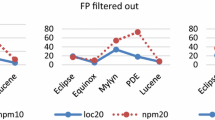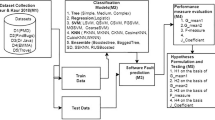Abstract
A novel kernel learning method for object-oriented (OO) software fault prediction is proposed in this paper. With this method, each set of classes that has inheritance relation named class hierarchy, is treated as an elemental software model. A layered kernel is introduced to handle the tree data structure corresponding to the class hierarchy models. This method was validated using both an artificial dataset and a case of industrial software from the optical communication field. Preliminary experiments showed that our approach is very effective in learning structured data and outperforms the traditional support vector learning methods in accurately and correctly predicting the fault-prone class hierarchy model in real-life OO software.
Similar content being viewed by others
References
Basili, V., Briand, L., Melo, W., 1996. A validation of object-oriented design metrics as quality indicators. IEEE Trans. on Software Eng., 22(10):751–761. [doi:10.1109/32.544352]
Berard, E.V., 1998. Metrics for Object-oriented Software Engineering. Available at http://www.ipipan.gda.pl/~marek/objects/TOA/moose.html
Bille, P., 2005. A survey on tree edit distance and related problems. Theor. Comput. Sci., 337(1–3):217–239. [doi:10.1016/j.tcs.2004.12.030]
Briand, L., Wust, J., 2002. Empirical Studies of Quality Models in Object-oriented Systems. Proc. Advances in Computers. Elsevier, London, p.98–167.
Briand, L., Wust, J., Daly, J., Victor, P.D., 2000. Exploring the relationships between design measures and software quality in object-oriented systems. J. Syst. Software, 51(3):245–273. [doi:10.1016/S0164-1212(99)00102-8]
Cartwright, M., Shepperd, M., 2000. An empirical investigation of an object-oriented software system. IEEE Trans. on Software Eng., 26(8):786–796. [doi:10.1109/32.879814]
Chang, C.C., Lin, C.J., 2001. LIBSVM: A Library for Support Vector Machines. Available at http://www.csie.ntu.edu.tw/~cjlin/libsvm
Chidamber, S., Kemerer, C., 1994. A metrics suite for object-oriented design. IEEE Trans. on Software Eng., 20(6): 476–493. [doi:10.1109/32.295895]
Collins, M., Duffy, N., 2002. Convolution Kernels for Natural Language. Proc. Advances in Neural Information Processing Systems. MIT Press, Cambridge, MA, USA, p.625–632.
Cortes, C., Vapnik, V., 1995. Support vector networks. Machine Learning, 20(3):273–297. [doi:10.1007/BF00994018]
Gartner, T., Flach, P.A., Kowalczyk, A., Smola, A.J., 2002. Multi-instance Kernels. Proc. 19th Int. Conf. on Machine Learning. Morgan Kaufmann Publishers, San Francisco, CA, USA, p.179–186.
Gartner, T., Lloyd, J., Flach, P.A., 2004. Kernels and distance for structured data. Machine Learning, 57(3):205–232. [doi:10.1023/B:MACH.0000039777.23772.30]
Haussler, D., 1999. Convolution Kernels on Discrete Structures. Technical Report USSC-CRL 99-10. Department of Computer Science, University of California at Santa Cruz, Santa Cruz, CA, USA.
Huang, P., Zhu, J., 2007. Decomposition method for tree kernels. LNCS, 4492:593–601.
Jin, X., Liu, Z.D., Bie, R.F., Zhao, G.X., Ma, J.X., 2006. Support vector machines for regression and applications to software quality prediction. LNCS, 3994:781–788. [doi:10.1007/11758549_105]
Kanmani, S., Uthariaraj, V.R., Sankaranarayanan, V., 2007. Object-oriented software fault prediction using neural networks. Inf. Software Technol., 49(5):483–492. [doi:10.1016/j.infsof.2006.07.005]
Kashima, H., Koyanagi, T., 2002. Kernels for Semi-structured Data. Proc. 9th Int. Conf. on Machine Learning. Morgan Kaufmann Publishers, San Francisco, CA, USA, p.291–298.
Khoshgoftaar, T.M., Allen, E.B., Hudepohl, J.P., Aud, S.J., 1997. Application of neural networks to software quality modeling of a very large telecommunications systems. IEEE Trans. on Neural Networks, 8(4):902–909. [doi:10.1109/72.595888]
Kuboyama, T., Shin, H.K., 2006. Flexible Tree Kernels Based on Counting the Number of Tree Mapping. Proc. Machine Learning on Graphs. Springer, Berlin, Germany, p.69–77.
Osuna, E., Freund, R., Girosi, F., 1997. Support Vector Machines: Training and Applications. Technical Report AI Memo 1602. Massachusetts Institute of Technology, Cambridge, MA, USA.
Pontil, M., Verri, A., 1998. Properties of support vector machines. Neural Comput., 10(4):955–974. [doi:10.1162/089976698300017575]
Scholkopf, B., Smola, A., Williamson, R., Bartlett, P.L., 2000. New support vector machine. Neural Comput., 12(5): 1207–1245. [doi:10.1162/089976600300015565]
Seliya, N., Khoshgoftaar, T.M., 2007. Software quality estimation with limited fault data: a semi-supervised learning perspective. Software Qual. J., 15(3):327–344. [doi:10.1007/s11219-007-9013-8]
Shawe-Taylor, J., Cristianini, N., 2004. Kernel Methods for Pattern Analysis. Cambridge University Press, New York. [doi:10.2277/0521813972]
Tang, M.H., Kao, M.H., Chen, M.H., 1999. An Empirical Study on Object-oriented Metrics. Proc. 6th Int. Conf. on Software Metrics Symp.. IEEE Computer Society, Washington, DC, USA, p.242–249. [doi:10.1109/METRIC.1999.809745]
Vapnik, V., 1998. Statistical Learning Theory. Wiley, New York.
Vishwanathan, S.V.N., Smola, A.J., Murty, M.N., 2003. SimpleSVM. Proc. 20th Int. Conf. on Machine Learning. IEEE Computer Society, Washington, DC, USA, p.760–767.
Xing, F., Guo, P., Lyu, M.R., 2005. A Novel Method for Early Software Quality Prediction Based on Support Vector Machine. Proc. 16th IEEE Int. Symp. on Software Reliability Engineering. IEEE Computer Society, Washington, DC, USA, p.213–222. [doi:10.1109/ISSRE.2005.6]
Zhang, K., Shasha, D., 1989. Simple fast algorithm for the editing distance between trees and related problems. SIAM J. Comput., 18(6):1245–1262. [doi:10.1137/0218082]
Author information
Authors and Affiliations
Corresponding author
Rights and permissions
About this article
Cite this article
Huang, P., Zhu, J. Predicting the fault-proneness of class hierarchy in object-oriented software using a layered kernel. J. Zhejiang Univ. Sci. A 9, 1390–1397 (2008). https://doi.org/10.1631/jzus.A0720073
Received:
Accepted:
Published:
Issue Date:
DOI: https://doi.org/10.1631/jzus.A0720073




